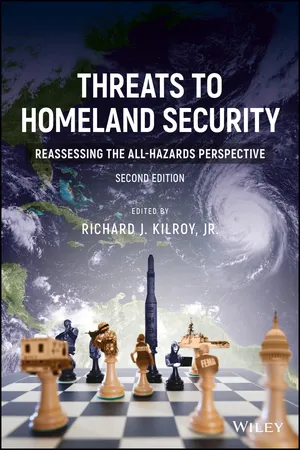
Threats to Homeland Security
Reassessing the All-Hazards Perspective
- English
- ePUB (mobile friendly)
- Available on iOS & Android
Threats to Homeland Security
Reassessing the All-Hazards Perspective
About this book
Addresses threats to homeland security from terrorism and emergency management from natural disasters
Threats to Homeland Security, Second Edition examines the foundations of today's security environment, from broader national security perspectives to specific homeland security interests and concerns. It covers what we protect, how we protect it, and what we protect it from. In addition, the book examines threats from both an international perspective (state vs non-state actors as well as kinds of threat capabilities—from cyber-terrorism to weapons of mass destruction) and from a national perspective (sources of domestic terrorism and future technological challenges, due to globalization and an increasingly interconnected world).
This new edition of Threats to Homeland Security updates previous chapters and provides new chapters focusing on new threats to homeland security today, such as the growing nexus between crime and terrorism, domestic and international intelligence collection, critical infrastructure and technology, and homeland security planning and resources—as well as the need to reassess the all-hazards dimension of homeland security from a resource and management perspective.
- Features new chapters on homeland security intelligence, crime and domestic terrorism, critical infrastructure protection, and resource management
- Provides a broader context for assessing threats to homeland security from the all-hazards perspective, to include terrorism and natural disasters
- Examines potential targets at home and abroad
- Includes a comprehensive overview of U.S. policy, strategy, and technologies for preventing and countering terrorism
- Includes self-assessment areas, key terms, summary questions, and application exercises. On-line content includes PPT lessons for each chapter and a solutions key for academic adopters
Threats to Homeland Security, Second Edition is an excellent introductory text on homeland security for educators, as well as a good source of training for professionals in a number of homeland security-related disciplines.
Frequently asked questions
- Essential is ideal for learners and professionals who enjoy exploring a wide range of subjects. Access the Essential Library with 800,000+ trusted titles and best-sellers across business, personal growth, and the humanities. Includes unlimited reading time and Standard Read Aloud voice.
- Complete: Perfect for advanced learners and researchers needing full, unrestricted access. Unlock 1.4M+ books across hundreds of subjects, including academic and specialized titles. The Complete Plan also includes advanced features like Premium Read Aloud and Research Assistant.
Please note we cannot support devices running on iOS 13 and Android 7 or earlier. Learn more about using the app.
1
THE CHANGING NATURE OF NATIONAL SECURITY: Understanding the Nature of Threats to Homeland Security and the US Response
Starting Point
What You’ll Learn in This Chapter
- The definitions of national security and homeland security
- The key players who formulate national and homeland security policy
- How changing international and domestic security environments affect national and homeland security policies
- The threats in a post‐9/11 world that impact national security policy issues
- Contemporary challenges to national and homeland security
After Studying This Chapter, You’ll Be Able To
- Analyze security environments and assess national and homeland security policy choices during specific historical periods
- Distinguish between national and homeland security policy players within government and outside government
- Appraise the threat situation in the post‐9/11 security environment
- Examine US national and homeland security and policy as a response to the changing security environment and threat perceptions
INTRODUCTION
1.1 Foundations of American Security Policy

1.1.1 Geopolitics at the Beginning of the Twentieth Century
Table of contents
- COVER
- TITLE PAGE
- TABLE OF CONTENTS
- NOTES ON CONTRIBUTORS
- PREFACE
- ACKNOWLEDGMENTS
- ABOUT THE COMPANION WEBSITE
- 1 THE CHANGING NATURE OF NATIONAL SECURITY
- 2 REASSESSING THE ALL‐HAZARDS PERSPECTIVE
- 3 US HOMELAND SECURITY INTERESTS
- 4 UNDERSTANDING THREAT ASSESSMENTS
- 5 CRITICAL INFRASTRUCTURE SECURITY, EMERGENCY PREPAREDNESS, AND OPERATIONAL CONTINUITY
- 6 STATE ACTORS AND TERRORISM
- 7 NON‐STATE ACTORS AND TERRORISM
- 8 CYBER‐CRIME, CYBER‐TERRORISM, AND CYBER‐WARFARE
- 9 WEAPONS OF MASS DESTRUCTION AND DISRUPTION
- 10 DOMESTIC TERRORISM
- 11 ENABLERS OF MASS EFFECTS
- 12 HOMELAND SECURITY INTELLIGENCE
- 13 HOMELAND SECURITY PLANNING AND RESOURCES
- REFERENCES
- INDEX
- END USER LICENSE AGREEMENT